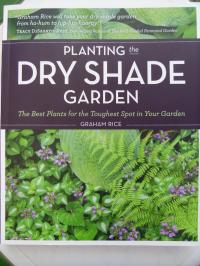Book Review - Planting the Dry Shade Garden

Invaluable advice for improving and planting the most difficult site in your garden.
4 Stars
Author: Graham Rice
Publisher: Timber Press
Published: 2011
ISBN: 13:978-1-60469-187-0
Planting the Dry Shade Garden -The Best Plants for the toughest spot in your garden is written by Graham Rice; a well known horticultural journalist who trained at the Royal Botanic Gardens, Kew. Graham has won many garden writing awards and written more than 20 gardening books. His wife Judy White is a garden writer/photographer and is respnsible for many of the excellent photos in the book.
Understanding Dry Shade
The first chapter of the book is entitled 'Understanding Dry Shade'. It begins by offering encouragement for the many gardeners that are daunted by the prospect of trying to improve the parts of their gardens that are both dry and shady. 'There is no reason why dry and shady areas cannot be as attractive as the landscaping in other areas of your property' explains Graham Rice.
He then moves on to explain and describe the different types of shade, e.g. the shade cast by fences, walls and buildings and how they get varying amounts of light at different times of the day, depending on which way they face. The author explains how even north facing walls provide a micro-climate and growing conditions that are actually perfect for some plants. Moisture levels found at the base of walls are explained and the impact of rain shadows are discussed.
The other type of dry shade most commonly encountered by gardeners is that found under mature trees. The shade cast by different types of trees is discussed as are the differing mositure levels found in the soil beneath both deciduous and evergreen trees. Specific trees are listed in groups according to how much shade they offer. The different types of root systems are explained and how they have an impact on the amount of moisture that is available for plants at the base of trees. Again, specific examples of trees that have both shallow and deep tap root systems are listed.
Coping with Dry Shade
The second chapter of the book is entitled 'Coping with Dry Shade'. This chapter looks at ways both prior and post planting to improve your lot and improve the dry shady site. Graham Rice says 'It all starts with broadening the choice of available plants. That depends on making the area less shady and less dry.'
The different techniques that can be used to improve the site are discussed such as the crown lifting and thinning of mature trees. There are different ideas for increasing the amount of moisture in dry, shady areas. Irrigation is discussed, the pros and cons of the different mulches available are assessed. The author also suggests how containerised plants can be positioned in dry shady areas to increase the range of plants available still further.
Choosing Plants for Dry Shade
Chapter 3 is the bulk of the book and is dedicated to the different plants that are tough enough to be happy living in a dry and shady site. Entitled 'Choosing Plants for Dry Shade' it is split into plant type sections e.g. Shrubs, Climbers, Bulbs etc. Each plant entry has 2 or 3 pages dedicated to it. There are some lovely, full page photographs that accompany the detailed plant descriptions. A history of the plant's cultivation is given, it's uses, dimensions and characteristics explained. The specific species and cultivars that are suitable for a dry and shady site are described. There are some unexpected and surprising plants that I would not have previously thought suitable for dry shade, so I will be giving them a go in my own garden. There are three day lilies listed for example; all proven to be happy and floriferous in dry shade.
At the end of the book there is a useful list of UK native plants that are suitable for a dry, shady garden. There are also suggestions for further reading if you want to broaden your knowledge of the subject still further.
Gardening Guru's Verdict
A really good book giving practical ideas for what is is probably the most difficult combination of site conditions that a gardener has to contend with. The book offers the reader all the necessary information to cope with this common horticultural dilema. The book will help the reader to understand dry shade, manipulate dry shade and most importantly it offers a comprehensive list of plants that will cope admirably with dry shade.
This book was reviewed by George Munford.
